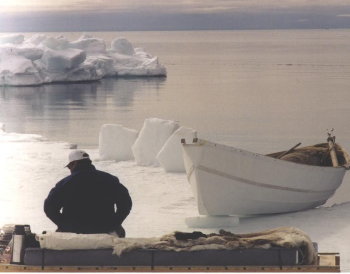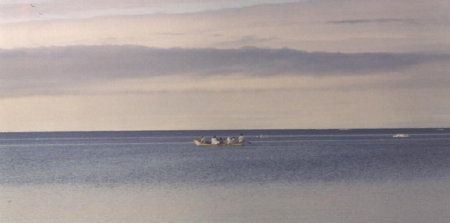
All rights reserved. Click at left to learn more.
 |
Charles
Wohlforth All rights reserved. Click at left to learn more. |
| Whaling
With Oliver Leavitt Crew Excerpts from The Whale and the Supercomputer. I took these photographs at the same time as the events described (the photos do not appear in the book).
|
 |
Sitting on the sled, Oliver was looking for
whales and
gauging the ice. In traditional spring whaling the umiaq perches
on the ice edge ready for launch. If a whale surfaces
nearby, the crew launches as quickly and quietly as possible and
paddles to the
whale or to a spot where the captain expects the whale to resurface.
For the
harpooner to hit the whale’s vulnerable spot, just behind the skull,
with a
harpoon made from a long pole of heavy lumber, the captain has to
maneuver the
boat right onto the whale’s back or within touching distance alongside.
The
whale can move much faster than the boat, so most of whaling is waiting
quietly
for a whale to come close enough to launch. In camp, no bright colors
are
allowed that might catch a whale’s eye and crews avoid unnecessary
noise and
movement. Hunters wear white, pull-over parkas lined with caribou hide
for camouflage
on the white snow. That morning we saw only one whale, a far-off black
back
rolling across the surface, and heard another, a roaring blowhole
exhalation
from somewhere we could not see, hidden by the ice. Normally at this
time of
year, a crew would be seeing whales every few minutes. Crews farther
down the
lead were paddling in search of one, thinking the migration might be
passing by
on the other side of the big ice across the lead.
|
 |